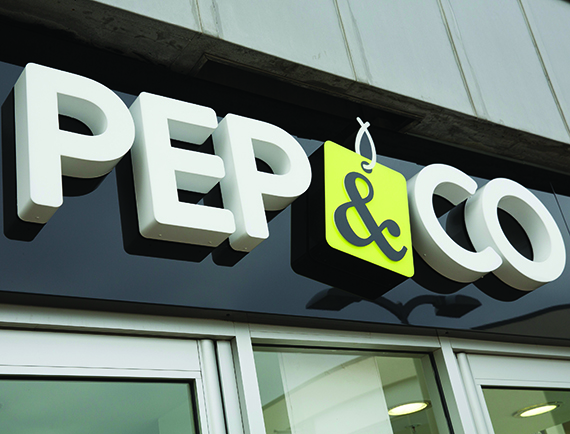Sean Gillies is looking forward to a well-earned rest. It has been a hectic 12 months for Savills’ executive director and head of retail since the proposed takeover of an existing retail business by his client – start-up value fashion retailer Pep & Co – suddenly went pear-shaped.
Last August, rather than having 200 stores across the UK lined up as planned (and the supply chain to service them), Gillies was faced with having none.
The situation, he acknowledges, was hardly ideal. With the clock ticking on a mid-2015 launch date, Pep & Co’s senior management – including ex-ASDA chief executive Andy Bond and former Sainsbury’s and Matalan director Adrian Mountford – opted to build up a 50-store network (the minimum number of stores needed to make stock ordering viable) from scratch. With typical understatement Gillies, who has worked with Pep & Co for two-and-a-half years since being recommended to the company, describes the plan as: “Feasible, but not without difficulties.”
One of those difficulties was talking round sceptical landlords. “They were initially nervous as they felt they were taking on an untried and untested concept,” admits Gillies, who is speaking on behalf of the company as none of the management wanted to comment to EG as they were “too busy opening stores”. “On the other hand they were impressed by the strength of the management and reassured by the financial backing [from South African Christo Wiese’s Pepkor] to the tune of £20m.” That reassurance was enough to persuade some landlords to agree terms across multiple shopping centres – Ellandi is home to eight and NewRiver to seven.
“One of the reasons nearly all of the 50 stores are in shopping centres is that we knew there would be greater flexibility and choice in getting the unit we needed.”
Previous research had identified more than 750 locations suitable for a Pep & Co. The Savills team of eight quickly got stuck in to identifying 50 prime candidates. The requirements for each store included a maximum size of 3,500 sq ft sales, plus up to 2,000 sq ft backroom space, and five-year lease terms that included a break after the second year. “One of the reasons nearly all of the 50 stores are in shopping centres is that we knew there would be greater flexibility and choice in getting the unit we needed,” explains Gillies.
There were nail-biting moments earlier in the year: for instance, when the retailer placed an £8m stock order in January, only six stores were in legals. But despite being tasked with “the largest organic opening by a new entrant in the UK ever”, Gillies remained unfazed and worked closely with the Pep & Co senior managers, who visited every prospective store location themselves, to achieve rental agreements that mirror the retailers strapline of ‘spend a little, get a lot’. With fit-out costs of up to £140,000 per store (previous fashion units preferred) the pressure was on to limit rental levels. Gillies will not disclose the numbers, but says the leases have generally been agreed on a pure turnover basis, with a threshold for rates and service charges.
The first store, in Kettering, launched on 1 July and, as EG went to press, Pep & Co was well on its way to achieving its goal of opening the 50 stores in 50 days. Retail commentators are divided on how the brand will fare in an already extremely competitive part of the sector. “Where they are going are not exactly salubrious locations – the danger is that will taint the brand,” suggests one, who declines to be named. But another is more positive: “Its property costs are going to be very competitive and it means its turnover figures are realistic.”
This month, with the first tranche of stores up and running, Gillies will sit down with the Pep & Co team to consider expansion prospects, although the retailer has been cagey about how many additional stores might open. “There are inevitably lessons to be learned from the first 50,” says Gillies. Future stores could be larger – up to 7,000 sq ft – and out-of-town locations, together with freehold ownership, may be in the frame.
“The biggest problem going forward is lack of space. Local Data Company figures show a 14% vacancy rate across the UK – but in reality it is not as clear-cut as that.”
Landlord’s viewpoint
An untested format is hardly the idea of a retail landlord’s dream tenant. So when Pep & Co came knocking, did community shopping centre investor Ellandi politely escort them to the nearest exit?
Hardly, responds investment director Mark Robinson, and for three good reasons: “Firstly, the quality of the management team – they have an established track record. Secondly, the backing from Christo Wiese and Pepkor. And lastly, the concept. We are interested in the growth of everyday retailing within the fashion sector. Put those three things together and they have a better-than-average chance of succeeding.”
“We have to be realistic, the days of retailers starting a new concept signing 20-year leases are long gone.”
In fact, Ellandi was convinced enough to sign up Pep & Co in eight of its current portfolio of 21 centres. Robinson chuckles when asked if he was concerned about the retailer’s get-out clause: “We are not worried as we made sure it was mutual. So if it is not working for us we can get someone else in. But we have to be realistic, the days of retailers starting a new concept signing 20-year leases are long gone.”
So Ellandi may well be interested in George Davies’ latest fashion brand FG4, which launched in the UK earlier this year, although only 10% of the proposed 200 UK stores are likely to be directly run. However, Robinson notes that dwindling supply (the average vacancy rate across Ellandi’s portfolio, for example, has dropped to 5%) will present a significant hurdle to new entrants. He adds: “Pep & Co timed its entry to perfection. If it went to market this time next year I am not sure it would work because they would be up against much higher occupational demand.”
Property prospects for emerging retailers
Shopping centre landlords are becoming increasingly choosy. That is the view of Ross Blyth, manager in KPMG’s retail advisory team. “During the recession they were more inclined to consider riskier tenants,” he explains. “Now they are willing to hold out for the right occupier.” That will vary from centre to centre, but it means the odds are heavily stacked in favour of an established retailer rather than a new kid on the block. Blyth notes that landlords are particularly likely to reject a tenant if they do not completely understand a prospective trader’s customer base and who the retailer wants to trade next to and why.
Retail property experts report that asset managers can take some convincing to embrace new or unproven brands and can be precious about tenant mix – particularly in prime shopping centres. “You can be the best-funded retailer going but if you do not appear to fit with the tenant mix, big-name shopping centres can be hard to get into, and these are the places you need to be in to gain your consumer relevance,” confirms Blyth. A top-notch agent (or internal acquisitions manager) will be critical for breakthrough retailers, he suggests, as not only will they open doors to the right centres, they are also likely to be most successful in negotiating the lowest rents.
These challenges might tempt start-up retailers towards shops in secondary locations where landlords might be more amenable and that, says Blyth, could be a big mistake as it may suggest that the brand itself is secondary, making it harder to appeal to shoppers and landlords alike: “Getting the first one or two stores right is vital in creating the right impression and following. Although expensive and challenging to secure, the impact of launching in a flagship location can help validate a brand.” However, this is proportionate – a primary location which is a fit for the brand does not always mean Regent Street or Bond Street, as Pep & Co’s Kettering launch demonstrates.
Start-ups which successfully negotiate the above hurdles are still likely to face stiff competition for more stores as vacancy rates across the UK’s key retail locations plummet. Blyth concludes: “We are likely to see new names, but I do wonder how many out-and-out new entrants there will be. The days of someone coming in saying: ‘I want 200 stores’ are probably gone.”












